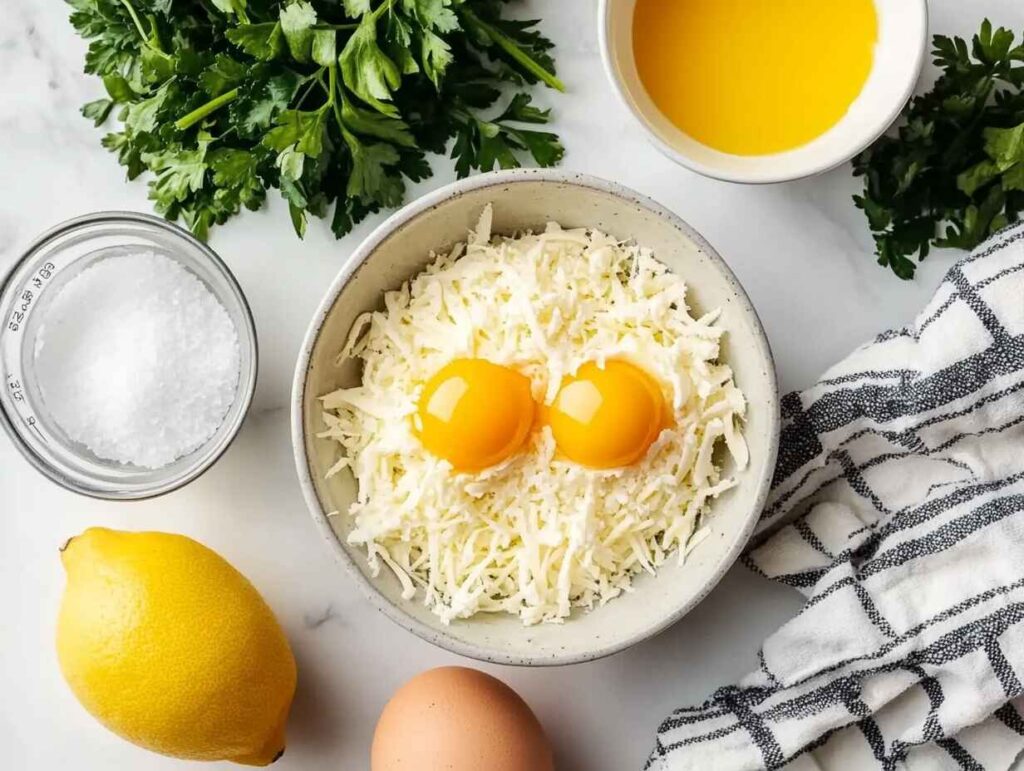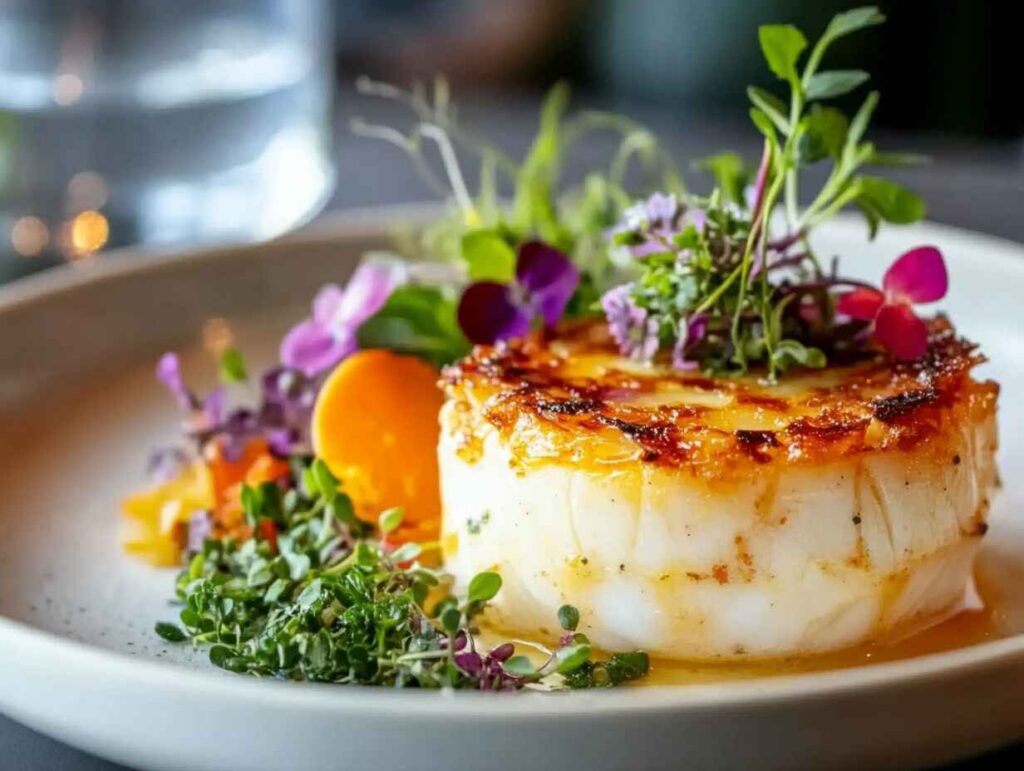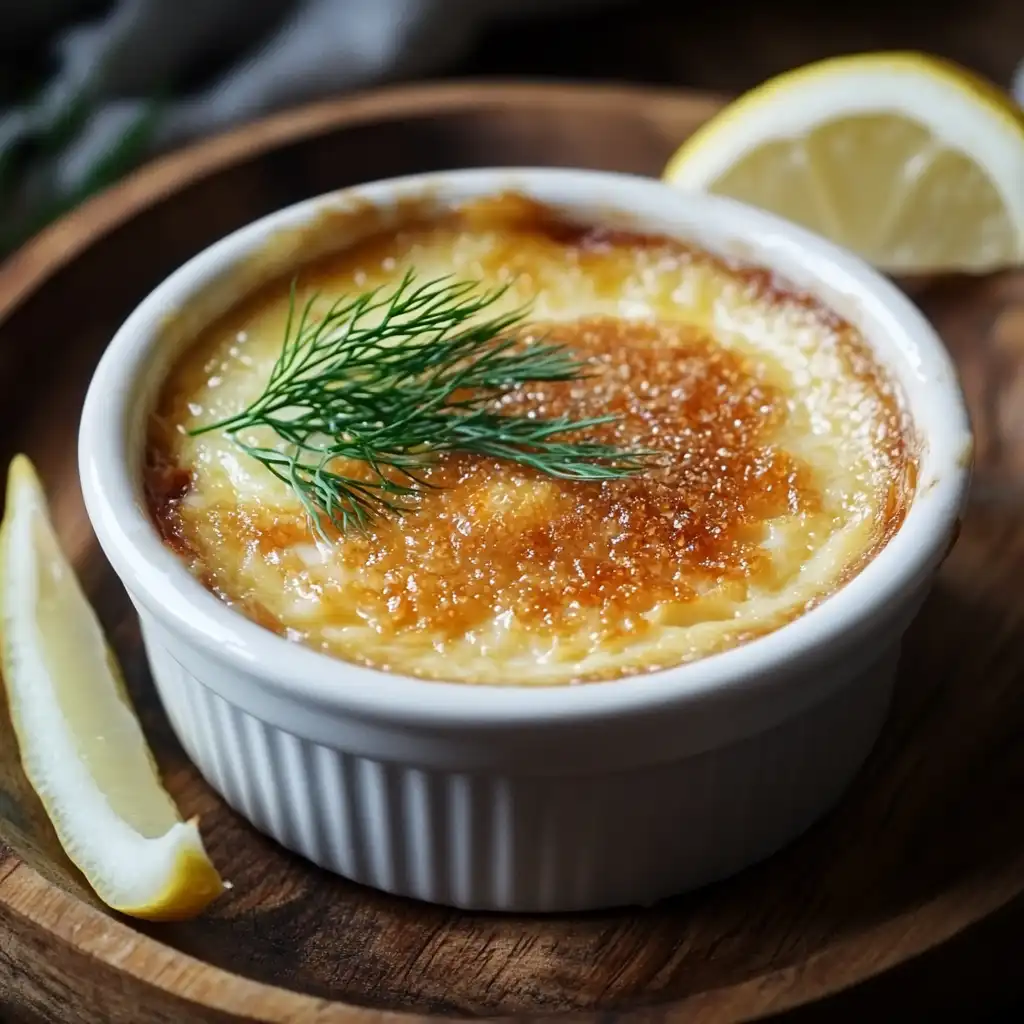Crab brûlée is a delicious and unique twist on the classic French dessert, crème brûlée. This crab brûlée recipe blends savory crab meat with a silky custard base and a sweet caramelized topping, creating an extraordinary flavor experience. Not only does it highlight the natural sweetness of crab with creamy richness, but it also offers a delightful contrast with a crispy sugar crust.
For dinner parties or special occasions, crab brûlée is the perfect choice. It impresses both in presentation and taste, leaving your guests talking about it long after the meal is over.
In this article, you’ll learn how to make crab brûlée step by step. Additionally, we’ll share tips for achieving the perfect caramelization and serving suggestions that are sure to wow your guests.
Table of Contents
Ingredients Needed for Crab Brûlée
To create a perfectly creamy and savory crab brûlée, you’ll first need a combination of fresh ingredients that truly highlight the dish’s luxurious flavors. Additionally, understanding what crème brûlée is made of can give you insights into creating your own twist on this classic dish
Main Ingredients
- Fresh Crab Meat – 1 cup (200g)
- Use lump or claw meat for the best flavor. Ensure it’s fully cooked and shredded.
- Substitution: Imitation crab or canned crab meat, but fresh is recommended for optimal taste.
- Heavy Cream – 1 cup (240ml)
- Essential for creating a rich custard texture.
- Substitution: Half-and-half can be used, but the texture may be slightly lighter.
- Egg Yolks – 4 large
- Provides the custard base with its creamy consistency.
- Tip: Save the whites for another recipe like meringue or an omelet.
- Parmesan Cheese – ¼ cup (30g), grated
- Adds a subtle umami boost to the custard.
- Salt – ½ tsp
- Enhances the natural sweetness of the crab meat.
- White Pepper – ¼ tsp
- For a delicate, spicy kick. Black pepper can also work but may alter the dish’s color.
- Nutmeg – A pinch
- Adds warmth to the custard’s flavor profile.
- Granulated Sugar – 2 tbsp
- Used for the brûlée topping. Opt for superfine sugar for even caramelization.
Optional Ingredients for Extra Flavor
- Chives or Fresh Dill – 1 tbsp, finely chopped
- Great for adding a fresh, herby garnish.
- Lemon Zest – ½ tsp
- Enhances the dish with a citrusy brightness.
- Paprika – A light sprinkle
- For a hint of smokiness.
Equipment You’ll Need
- Ramekins: Small, oven-safe dishes to bake the custard.
- Mixing Bowl: For whisking the custard ingredients.
- Strainer: To achieve a silky custard by removing any lumps.
- Kitchen Torch: For caramelizing the sugar topping.
- Baking Dish: To create a water bath for even cooking.
Ingredient Substitution Tip:
For a slightly healthier version, you can replace half of the heavy cream with milk. However, this may result in a lighter custard.

Step-by-Step Preparation of Crab Brûlée
Now that you have all the ingredients ready, it’s time to dive into the preparation process. Follow these steps carefully to achieve a silky, savory custard with a perfectly caramelized topping.
1: Prepare the Crab Custard
- Preheat the Oven
- Set your oven to 325°F (165°C). This temperature ensures slow, even cooking for the custard.
- Whisk the Egg Yolks and Cream
- In a mixing bowl, combine the 4 egg yolks and 1 cup of heavy cream. Whisk until smooth and fully incorporated.
- Season the Custard
- Add the grated Parmesan cheese, salt, white pepper, and a pinch of nutmeg to the mixture. Whisk again to blend the flavors.
- Incorporate the Crab Meat
- Gently fold in the shredded crab meat. Be careful not to break the delicate lumps of crab. For more details on achieving the right custard texture, explore the difference between crème brûlée and custard.
- Strain the Mixture (Optional)
- For an extra-smooth custard, pour the mixture through a fine mesh strainer to remove any lumps or egg solids. If you skip this step, whisk thoroughly to ensure a uniform texture.
2: Fill and Bake
- Prepare the Ramekins
- Divide the mixture evenly among your ramekins. Each should be about ¾ full to leave room for the caramelized topping.
- Set Up a Water Bath (Bain-Marie)
- Place the filled ramekins in a large baking dish. Pour hot water into the dish until it reaches halfway up the sides of the ramekins. This step ensures even cooking and prevents the custard from curdling.
- Bake the Custard
- Carefully transfer the baking dish to the preheated oven. Bake for 30–40 minutes, or until the custards are just set. The center should jiggle slightly when shaken.
- Cool the Custards
- Remove the ramekins from the water bath and let them cool to room temperature. Then, refrigerate for at least 2 hours to allow the custard to firm up.
3: Create the Brûlée Topping
- Sprinkle the Sugar
- Once the custards are chilled, sprinkle ½ to 1 teaspoon of granulated sugar evenly over the surface of each custard.
- Caramelize the Sugar
- Caramelize the Sugar: Using a kitchen torch, gently heat the sugar until it melts and forms a golden, crispy layer. Move the torch in a circular motion to ensure even caramelization. Learn more about how to master caramelization in brûlée by reading how to caramelize crème brûlée.
- Cool the Topping
- Allow the caramelized sugar to cool for a minute or two. It will harden into a crackly crust.
Pro Tip:
Avoid torching the sugar too early before serving, as the crust may soften in the refrigerator.
Tips for Perfecting Your Crab Brûlée
Creating a luxurious crab brûlée requires careful attention to detail. By following these tips, you can ensure your crab brûlée turns out perfectly every time, with a creamy custard and a flawless caramelized crust.
1. Selecting the Right Crab Meat
- Use Fresh Crab Meat: First and foremost, always choose freshly cooked lump or claw crab meat for the best crab brûlée. Fresh crab delivers exceptional flavor and texture. Be sure to check that the meat is free of shells and cartilage for a smooth custard experience.
- Frozen or Canned Options: If fresh crab is unavailable, high-quality frozen or canned crab meat can work well in crab brûlée. However, make sure to drain it thoroughly to avoid adding excess moisture that could impact the custard.
2. Achieving the Perfect Custard Texture
- Don’t Overcook: To start, ensure that the custard for your crab brûlée is just set with a slight jiggle in the center. Overbaking can easily result in a rubbery texture.
- Water Bath is Key: Furthermore, the bain-marie method provides even heat distribution, which is essential for preventing curdling or cracking in your crab brûlée.
3. Mastering the Caramelized Topping
- Use Even Layers of Sugar: For the best results in your crab brûlée, spread granulated sugar in a thin, uniform layer over the custard to ensure consistent caramelization.
- Move the Torch Constantly: Additionally, keep the kitchen torch moving in a circular motion to avoid burning any one spot. Aim for a beautiful golden-brown topping to enhance your crab brûlée.
- Broiler Backup: If you’re using a broiler instead of a torch, place the ramekins on the top rack and watch closely to avoid scorching the sugar.
4. Enhancing the Flavor Profile
- Add Herbs: For extra flavor, sprinkle chopped chives, dill, or parsley on top of your crab brûlée. These herbs complement the dish’s savory notes beautifully.
- Citrus Twist: Alternatively, a small amount of lemon zest mixed into the custard or used as a garnish can brighten the flavor profile of your crab brûlée.
- Subtle Heat: If you’re feeling adventurous, add a pinch of cayenne pepper or smoked paprika to the custard mixture for a touch of spice, making your crab brûlée even more unique.
5. Serving Like a Pro
- Chill the Custard: Before adding the brûlée topping, ensure the custards are completely chilled to achieve the best texture contrast between the creamy base and the crispy topping of your crab brûlée.
- Plate with Elegance: When serving, place the ramekins on small plates and garnish with edible flowers, fresh herbs, or a wedge of lemon for a sophisticated presentation of your crab brûlée.
6. Storing Leftovers
- Refrigeration: If you have leftovers, cover and refrigerate them without the sugar topping for up to 2 days. When you’re ready to serve, simply add the caramelized sugar for a fresh finish to your crab brûlée.
- Avoid Freezing: Keep in mind that custards like crab brûlée do not freeze well, as they tend to separate and lose their creamy texture when thawed.
Pro Tip:
Experiment with different serving sizes by using smaller ramekins for bite-sized portions of crab brûlée. This approach is perfect for appetizers at a dinner party and adds an extra layer of creativity to your presentation.
Serving Suggestions for Crab Brûlée
Once you’ve mastered the art of making crab brûlée, the next step is presenting and pairing it to impress your guests. If you’re curious about the flavor, discover what crème brûlée tastes like.
1. Plating the Dish
- Keep It Simple: Serve the crab brûlée directly in its ramekin to maintain its elegance and simplicity.
- Garnish for Visual Appeal: Add a sprig of fresh herbs like dill or parsley to the top for a pop of color. A small wedge of lemon on the side complements the seafood flavors.
- Add Edible Flowers: For a special occasion, a small edible flower placed on the plate can add a gourmet touch.
2. Ideal Accompaniments
- Light Greens: Pair the crab brûlée with a side of mixed greens drizzled with a citrus vinaigrette. The acidity balances the richness of the custard.
- Crackers or Crostini: Offer a basket of toasted crostini or gourmet crackers as a crunchy contrast to the creamy brûlée.
- Soup Pairing: Consider serving it alongside a light seafood bisque or a chilled gazpacho for a complete appetizer course.
3. When to Serve Crab Brûlée
- As an Appetizer: It’s a sophisticated starter for a dinner party or formal gathering. Serve it before the main course to set the tone for the meal.
- For Special Occasions: Crab brûlée makes an excellent centerpiece for romantic dinners, holiday celebrations, or milestone events.
- As a Tasting Dish: Serve in smaller ramekins as part of a tasting menu or seafood platter.
4. Presentation Variations
- Mini Portions: Use small ramekins or even spoons to create bite-sized portions of crab brûlée for a buffet or cocktail party.
- Add Seafood Toppings: A small piece of seared scallop or shrimp placed on top of the brûlée can add extra flair and flavor.
- Layered Presentation: Serve the brûlée in clear glass jars to show off the custard and caramelized topping layers.
Pro Tip:
For a stunning visual impact, serve the crab brûlée on a slate or wooden board, surrounded by accompaniments like crackers, herbs, and citrus slices.

Frequently Asked Questions (FAQs) About Crab Brûlée
Before you wrap up your culinary adventure with crab brûlée, let’s address some common questions and concerns. These FAQs will help ensure your experience with this dish is smooth and enjoyable.
1. Can I Make Crab Brûlée in Advance?
Yes, you can absolutely prepare the custard a day ahead. First, bake the custards, let them cool, and then store them in the refrigerator without the sugar topping. When you’re ready to serve, simply add the sugar and caramelize it for a fresh, crispy crust. This method saves time while ensuring the dish remains delicious.
2. What Can I Use Instead of a Kitchen Torch?
If you don’t have a kitchen torch, don’t worry. Instead, you can use your oven’s broiler. To achieve the best results, place the ramekins on the top rack and keep a close eye on them as the sugar caramelizes. However, be careful not to leave them unattended, as the sugar can burn quickly under the intense heat.
3. Can I Freeze Crab Brûlée?
Freezing is not recommended. Custards tend to separate and lose their creamy texture when thawed. Instead, it’s best to refrigerate the custards for up to 2 days. This approach ensures the texture and flavor remain intact, making your dish as delightful as when it was first made.
4. What Are Some Substitutions for Heavy Cream?
If you need a substitution, you can replace half of the heavy cream with whole milk for a lighter custard. That being said, the texture may not be as rich as when using full heavy cream. Alternatively, non-dairy options like coconut cream can work well, though they will introduce a different flavor to the dish.
5. How Do I Ensure the Sugar Crust is Perfect?
To achieve a flawless sugar crust, use superfine sugar for an even layer that melts quickly and uniformly. Additionally, avoid sprinkling too much sugar, as a thick layer may burn before caramelizing evenly. Finally, practice using the torch to maintain a steady hand and even movement for the perfect golden-brown finish.
6. Can I Make This Dish Vegetarian?
While crab brûlée is traditionally made with crab as the star ingredient, you can easily create a vegetarian version. For example, substitute the crab with finely chopped mushrooms or artichoke hearts, which provide a similar texture and umami flavor. This alternative ensures you can still enjoy the unique concept of crab brûlée while accommodating guests with dietary preferences.
Conclusion
Crab brûlée is an extraordinary dish that combines the elegance of classic French cooking with the delicate flavors of seafood. Perfect for impressing guests or elevating a special meal, this crab brûlée recipe offers a creamy, savory custard topped with a satisfying caramelized crust. By incorporating the tips, variations, and serving ideas provided in this guide, you are now well-equipped to master the art of making the perfect crab brûlée. Whether served as an appetizer or a centerpiece dish, crab brûlée is sure to leave a lasting impression on your guests.

